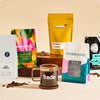The big, beautiful Coffee Taster’s Flavor Wheel is more than just a lovely image to hang above your coffee-brewing equipment: It’s also a tool that can be used not only to identify and describe the flavors that might express themselves in your coffee, but also to begin to understand them.
Of course, it helps if you know how to use the thing, so we’ll tell you a little about the flavor wheel's creation, its intended purpose, and how it can help you enjoy your favorite brew in totally new ways.
Inventing the “wheel”
Back in the 1990s, when the specialty coffee industry was a teenage upstart trying to strike out more independently from big-time commercial coffee, its caffeinated leaders often looked to the wine world for inspiration and direction. One of the most obvious places to direct that seeking gaze was the Viticulture and Enology department at University of California, Davis (UC Davis) which, in 1984, first published Professor Ann C. Noble’s Wine Aroma Wheel.
Noble’s intent was to organize certain commonly found aromatic qualities in red and white wine in a way that allowed users to not only more specifically describe what they were perceiving, but also potentially trace them back to their root cause, be it terroir, processing, aging, and so on. Naturally, that origin-tracing requires a bit more advanced study — after all, it was designed for wine higher education — but ideally it can be used by anyone who has developed a memory bank of aromas and flavors that they’ve experienced, which can be applied to describe and enjoy the complexities and nuance found in wine.
Just over a decade later, specialty coffee “grew up” enough to develop its own such tool, and the first Coffee Taster’s Flavor Wheel was officially released by the then Specialty Coffee Association of America in 1995. Specifically, it was meant to be used for quality control, and for the purposes of identifying, cup-scoring, and trading solely specialty coffee (which has far more nuance than commercial-grade stuff). It was a labor of love for the SCAA’s executive director at the time, Ted Lingle, and it created the first visual representation of coffee flavor and coffee quality to be used by anyone working or interested in sensory analysis within the field: producers, exporters, importers, roasters, even the occasional coffee nerd (like all of us who love Trade).
After years of refining and re-evaluating, the specialty coffee trade association dramatically re-imagined the taster’s wheel in 2016, just over 20 years since the original appeared. Today’s Coffee Taster’s Wheel contains more nuance, updated flavor descriptors, and a dynamic new design to make it easier and more comprehensive to use.

Wait, these flavors are in my coffee?
Don’t be alarmed: No one is sneaking blueberry syrup or chocolate powder into your coffee beans, we promise! The flavors that the wheel lists, and the flavors your favorite coffee roaster lists on their packaging, are not created by additives, but are rather inherent to the coffee beans themselves.
There are lots of variables that create coffee flavor, including the beans’ country of origin, the coffee’s genetic variety, the type of processing the coffee went through after harvesting, the roasting style, and more. For instance, the coffee variety Gesha often tastes and smells very floral, like jasmine or honeysuckle; on the other hand, the coffee variety Bourbon tends to be less floral and more sweet, like butterscotch or brown sugar. Washed process coffees might be crisp and stone-fruity, while natural process beans are more like blueberries or stewed strawberries.
Coffee is the most complex food or drink that we consume, which means that it has even more flavor and aroma compounds than red wine. While all of your favorite coffees might “taste like coffee,” there’s a symphony of flavors in there that make each one unique and special. The Coffee Taster’s Flavor Wheel is one tool that can help you start to recognize all the different individual parts that make up that beautiful caffeinated symphony.
How to use the flavor wheel
Don’t worry, you don’t need to be a “coffee expert” in order to use the flavor wheel, though there are certainly advanced ways to interact with it (more on that in a moment). The most basic approach is to follow a “center out” description track, starting with the most general flavor note in the center ring (EG “floral,” “fruity,” “sweet”) and move toward the outward rings. The second ring contains terms that classify flavors into clusters, such as breaking up “fruit” into the categories of dried fruit, berry, citrus, or other fruits. The use then can move to the outermost ring to find a specific descriptor. “Other fruit,” for example, contains things like cherry, coconut, grape, and pineapple.
Defects are located at the bottom of the wheel, and include nasty flavors we’re sure you’ll never taste in the coffees you get from Trade: salty, medicinal, skunky, rubber — these are all descriptors that are used to weed coffees out before they’re purchased by a roaster, so you can rest assured you don’t have to pay much attention to this part of the wheel. (That is, unless you have a morbid curiosity about what truly bad coffee tastes like.)
Interested in making your palate a fine-tuned tasting machine? You can use the Sensory Lexicon developed by World Coffee Research (WCR) in order to literally taste the rainbow: The organization published this resource independently from, but based on the Flavor Wheel, in order to provide coffee tasters with a useful and relevant set of reference flavors, which can help identify particular notes in coffee.
The WCR Lexicon is available for free download, and it provides clear and easy instructions to make flavor reference samples that correspond with the wheel. For instance, if you want to explore the category “brown spice,” you can follow the lexicon’s recipes to combine and/or compare notes of nutmeg, allspice, clove, and cinnamon.
When used in combination, the Coffee Taster’s Flavor Wheel and the WCR’s Sensory Lexicon can be a wonderful palate-development tool, as well as just a lot of fun! Tackle one small section every week or month and see how your awareness of flavor as well as your ability to detect nuance in coffee notes improves over time.
How can I tell what my coffee “tastes like"?
Feel like all of this is too advanced for you? Don’t worry. Remember that these are resources designed for professionals, so they are more detailed than you might need when you’re trying to simply enjoy your morning cup.
The best way to start identifying nuanced flavors in your coffee is to start paying close attention to the not-coffee things you consume. Savor a square of chocolate and try to remember the sensation, taste a squirt of lemon juice and pay attention to how it plays on your tongue. Slowly chew a handful of nuts so that the flavor lingers on your palate. In other words, treat yourself to a snack, spend some intentional time with it, and call it “practice!”
Above all else, however, remember that tasting coffee is supposed to be part of what makes it fun, not work: You don’t have to be an expert to know what tastes good to you — that’s why we’re here to always help you match with the delicious coffees you love!









